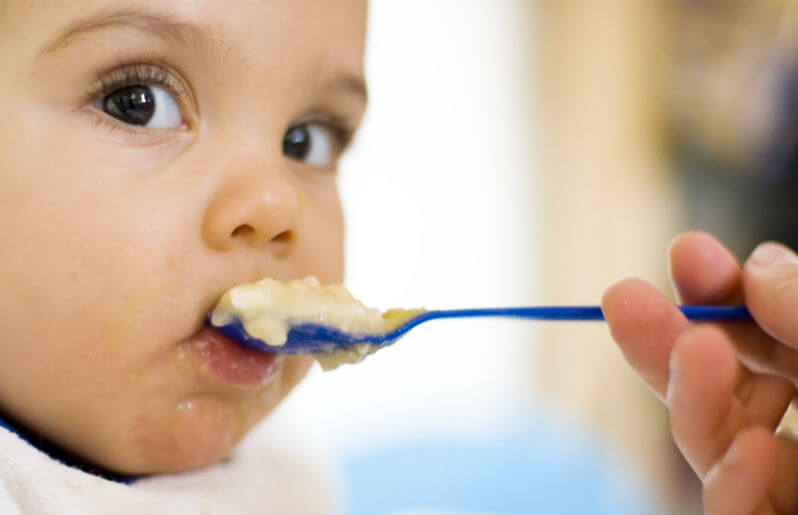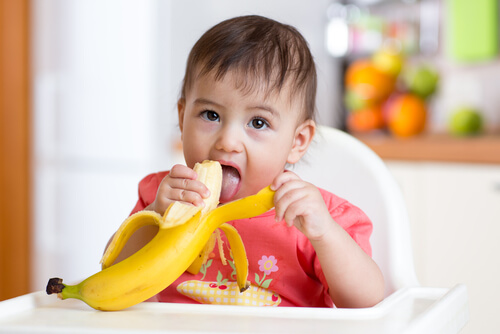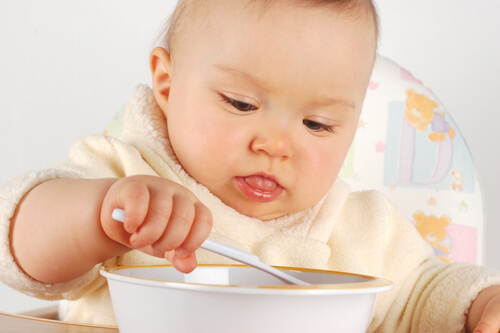The First Foods You Should Give Your Baby

According to the American Pediatrics Association, babies should begin eating solids by the time they are between 4 and 6 months old. In addition to age, there are other specific factors of development that doctors take into account to determine when children are ready to try their first foods.
Here are some of the main signs to look out for – when these appear, you’ll know that your baby is ready for a varied solid diet:
- Your baby has lost their extrusion reflex. This is the reflex that makes them push a spoon or food out of their mouth.
- Your child shows interest or curiosity when other people are eating around them. They may try to reach for food.
- Even if they still need to lean against something, your baby is able to sit up and control their head.
- Your baby’s weight has doubled from birth.
When the time comes to incorporate solid foods into your baby’s diet, take care to make the right choices for their stage of physiological development. Preparing foods in the right way is also key for a healthy and nutritious diet.
Below, we will take a look at some of the first foods that you can include in your baby’s meals.
4 types of solid food for babies to try
1. Avocado
This is an excellent choice for babies who are just beginning to eat solid food. Avocado contains healthy fat for growth and development. Its soft, creamy texture is ideal for a baby’s delicate digestive system.
This fruit is rich in vitamin A, C, niacin, folate, potassium, phosphorus, iron, magnesium and calcium. To prepare it, just remove the skin and pit, cut out a portion and mash it with a fork.
“We are all born equal: diet is where the differences begin”
-Dr. Hernan Jaramillo Botero-
2. Banana
Bananas are also an ideal food for babies. The properties of banana makes it perfect for babies to digest. The sweet flavor and soft texture of this fruit is tempting for little ones, and it contains vitamin A, C, folate, potassium, phosphorus, magnesium and calcium.
Before giving your baby banana, peel the fruit and mash it into a puree. If you want it to be even smoother, you can heat it a little. You could also add a little breast milk or some of the formula you are using to make a mixture that is easier for your baby to eat.

3. Meat
When your baby begins to eat a solid diet, they are prone to deficiencies of certain nutrients. The most common of these are iron, zinc and vitamin B12, all of which are present in animal products.
Although iron is present in vegetables, this type is more difficult for a young digestive system to absorb.
Given this, it is a good idea to include a portion of meat in your child’s meals. A good way of giving your baby meat is to cook it well and process it in the blender. Check that it is good quality.
You can soak meat in a little water or stock (with no salt) to make it easier to process.
“A good way of giving your baby meat is to cook it well and process it in the blender. Make sure it is good quality”
4. Mango
This sweet tropical fruit offers a variety of nutrients for your baby’s growing body. Mango is rich in vitamins A, C, E, K, folate, potassium, phosphorus, magnesium, calcium and sodium. As with other foods, peel it, remove the pit and mash it to a smooth puree.

Recommendations for your baby’s diet
- Breast milk or formula should still be a part of your baby’s diet at this age, even if you are giving them solids. Milk provides the main source of calories and nutrients for babies in their first year of life.
- At mealtimes, try to make sure your baby is calm, clean and contented. This way, they will be able to enjoy their food and will associate meals with positive feelings.
- Choose one food at a time to introduce. Give them this for a few days before trying anything else. This way, any allergic reactions will be easy to spot.
- If you notice diarrhea, a rash or vomiting after eating any food, cut it out of their diet and consult with your doctor.
- If you are going to give your baby grains or cereals, make sure they are age-appropriate. Cereals made especially for little ones are often fortified with specific nutrients.
Even though it is not solid, meat broth without salt or spices is also good for babies. With its easy-to-digest texture and balance of nutrients, it is ideal for your baby’s body to process.
Another recommendation to keep in mind is to always check that the food you give your child is fresh and high quality.
This way you can be sure that you are developing healthy eating habits from the very first few months of your child’s life.
All cited sources were thoroughly reviewed by our team to ensure their quality, reliability, currency, and validity. The bibliography of this article was considered reliable and of academic or scientific accuracy.
- Agència de Salut Pública de Catalunya. Recomendaciones para la alimentación en la primera infancia (0 a 3 años). 2016. Agència de Salut Pública de Catalunya
- Gómez Fernández-Vegue M. Recomendaciones de la Asociación Española de Pediatría sobre la Alimentación Complementaria. Noviembre 2018. Asociación Española de Pediatría.
- He H., Qiao Y., Zhang Z., Wu Z., et al., Dual action of vitamin C in iron supplement therapeutics for iron deficiency anemia: prevention of liver damage induced by iron overload. Food Funct, 2018. 9 (10): 5390-5401.
- Martins BP., Bandarra NM., Figueirido Braga M., The role of marine omega 3 in human neurodevelopment, including autism spectrum disorders and attention deficit/Hyperactivity disorder- a review. Crit Rev Food Sci Nutr, 2020. 60 (9): 1431-1446.
- Organización Mundial de la Salud. Alimentación del lactante y del niño pequeño. Junio 2021.
- Romero Velarde E, Villalpando-Carrión S, et al. Guidelines for complementary feeding in healthy infants. Topics in Pediatrics. Septiembre-Octubre 2016. 73 (5): 338-356.
- Salemi C. Ventana óptima de introducción de alimentos y prevención de alergias alimentarias en lactantes de alto riesgo. Anales Venezolanos de Nutrición. 2020. 33 (1).